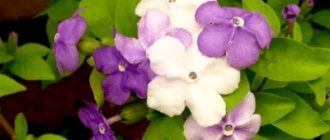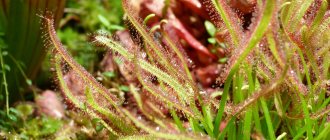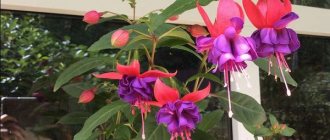No gardener will refuse the pleasure of growing such a chic and fascinating plant as an orchid. Looking at a photo of an orchid, you want to admire it over and over again and get yourself such a plant. Even the capricious nature of the plant and the peculiarities of its care are not intimidating.
Not everyone can cope with the peculiarities of caring for an orchid, so it’s worth studying everything in detail. How to care for a plant at home, what are the features of watering, what to fertilize, how to fight pests.
Before purchasing, it is worth determining the living conditions for the orchid, taking into account lighting, drafts, temperature, and air humidity. You will need to really stretch your brain to find a suitable place.
There are many thousands of orchid species, and each has many individual characteristics and subtleties. The selection should be guided by personal tastes and capabilities.
After purchasing a plant, inspect it for diseases and pests. If there are no visible problems, the pot matches the size of the flower and you are satisfied, then replanting will not be required.
Origin story
In the early 19th century, a European importer of tropical plants received interesting bulbous stems in a shipment that were used as packaging material. Out of simple curiosity, he planted them. A very beautiful pale lilac flower has grown. Gradually, their cultivation was brought to a commercial level. Soon they began to visit the tropical jungle in order to search for new species of these exotic plants. Many of them were not transported to their destination, since not all specimens survived the long sea voyage. But those plants that were brought to Europe were very expensive. Later, artificial hybrids began to be grown, and orchids dropped significantly in price. But even now there are rare varieties of these flowers, the price of which reaches $25,000.
Nowadays flower shops have special departments where they sell these plants of any color and size. Also, experienced sales specialists will provide the necessary advice on care after purchase.
We recommend that you read our article “How to choose fertilizers for orchids.”
Feeding
The orchid substrate contains either very few or no nutrients. Therefore, when watering, it is necessary to regularly fertilize, and do this throughout the year. Choose liquid fertilizers that are suitable for the corresponding stage of development of your orchid: during flowering, once every 15 days, use a fertilizer that contains a lot of phosphorus; After the flowers fall, when new shoots are actively forming, it is better to use nitrogen fertilizer. In any case, it will always be useful to feed the plant with complete mineral fertilizer. Apply fertilizer during every 4th watering. All of them are widely available.
Features of flower culture
The unique feature of orchids is their endless variety of colors and shapes. Most likely, this is what attracts gardeners to these flowers, because they can be quite inconspicuous; there are even varieties whose flowers are 2 millimeters in size. Orchids also differ in their methods of reproduction. Their seed capsules contain about 2 million seeds, which are easily dispersed by the wind. But for them to grow, they need a special mushroom to supply them with nutrients.
Although not unusually beautiful, the flower does not have pollen to attract pollinating insects, and not all species even have nectar. Therefore, the main advantage of these flowers is considered to be beauty, camouflage and aroma.
Today, more than 75,000 species of orchids are known.
Bloom
The flowering of an orchid can last up to six months , since the flowers on its peduncle bloom gradually. The flowers are on average 9 cm in diameter and have various shades of red: from soft pink tones to dark burgundy.
Flowering of different varieties of orchids.
Therefore, when watering a plant during flowering, you must adhere to certain rules:
- water should not get on the flowers - they lose their appearance and wither;
- water should not accumulate in the axils of the leaf blades - this causes the development of fungal diseases and the death of the bush;
- water only with warm water, removing excess water after watering;
- the soil should not dry out completely.
When watering an orchid of any kind, you must remember that it is better to underwater it than to overwater it. After all, from excess watering, the flower’s root mass begins to rot.
IMPORTANT! If water remains in the axils of the leaf blades after watering, it must be carefully removed using paper napkins.
Flower cultivation
Many of us know that in their homeland these flowers can grow freely on other plants, for example, in the crowns of large trees, but this does not mean that they cannot be grown at home, in ordinary pots. Therefore, today we are looking at the features of growing orchids and learning how to propagate them at home.
In what containers should I grow orchids at home?
Most often, at home, flowers are planted in pots, plastic or clay. Which option should I choose?
Growing orchids in clay pots often leads to their disease and wilting. This happens for many reasons, including minimal space for roots, moisture absorption and roots sticking to the surface of the vessel, as well as poor water drainage, due to which the rhizomes can rot.
With plastic pots, everything is a little different, and that is why floristry experts recommend using exclusively plastic containers for growing orchids.
In such cube-shaped containers there are no places where the root system will be pinched and suffer from a lack of free space for development. Most often, plastic containers are equipped with good water drainage and stands, due to which not only excess moisture is removed from the container, but also the root system has the opportunity to be ventilated. These factors create the most convenient conditions for development for the orchid.
Priming
The life of an Orchid largely depends on the quality of the soil, which is inferior to ordinary garden soil.
Important!!!
With the correct selection of soil, the possibility of plant rotting is completely eliminated, and the process of providing the flower with oxygen and removing moisture from the root system also occurs.
Beginners are recommended to purchase a ready-made mixture. More experienced gardeners can try preparing the soil themselves.
Soil for orchids
The following components are suitable as fillers:
- Peat.
- Sphagnum moss.
- Charcoal.
- Bark of tree.
Their percentage may be the same.
Orchids: cultivation and care
Growing temperature
Orchids feel quite good at home, even of the standard type. For a comfortable life, they need a temperature of +25+30°C, but in winter they should ensure a temperature of +20°C. But you should not take flowers out onto balconies and terraces, where the air temperature can drop below +13+14°C, as in such conditions they will quickly die or begin to get seriously ill.
Accommodation
Orchids are very demanding of lighting, and therefore, if you provide the brightest day possible and a little additional light in winter, you will systematically receive pleasant plant growth and abundant flowering. But be careful, because the hot summer rays can seriously burn the leaves.
It would be most correct to place a flower pot on the east window, but if this is not possible, then windows on the south or west side will do. Soon the plant itself will tell you whether it has enough light in the place where you installed it. If the leaves begin to lighten, then you will need to shade the plant a little; if they take on deep green tones, then, on the contrary, install it in a more illuminated place.
Watering the plant
Orchids love moisture, however, watering should be moderate so that the soil is not flooded and water stagnation does not form in it. The ideal would be to systematically moisten the soil, without excessive amounts of water.
Humidity
Keeping a flower crop indoors will require adjusting the humidity, but this does not mean that the plant will need to purchase a greenhouse with fogging; it will be enough to grow the flower at a humidity of 70% or spray it if the humidity drops to 40-50%.
How to fertilize
Plants need nutritious soil and actively consume nutrients necessary for growth and flowering. It would be most correct to provide the flower with fertilizing during every second or third watering. Azofoska (1 g per 1 liter of water) is best suited for such frequent feeding. You can also fertilize with magnesium sulfate (2 g per 1 liter of water), but it is better to spray the plant with this solution (only once every 25-30 days).
How much light do you need?
Lighting is considered the main factor in the question of how to care for an orchid. It is the light that determines whether a plant will bloom or not.
During the development period, the flower requires a duration of daylight hours, ranging from 12 to 15 hours. In winter, the lack of natural light is compensated by artificial light from fluorescent lamps.
The lighting should be bright, but diffused; direct sunlight should be avoided on the flower. In such cases, the plant needs to be shaded, otherwise it may simply burn.
Orchid propagation
Transplantation and propagation of a crop can occur in several ways, and therefore you have an excellent opportunity to choose the most convenient one for yourself.
Propagation by dividing rhizomes
A fairly simple method that, as they say, can be used to propagate almost any type of orchid. You need to select an adult and large enough plant, carefully remove it from the pot or container and separate the rhizome from its walls and earthen ball. The rhizome should be divided with a very sharp knife, cutting it into any number of parts, the main thing is that each of them has at least 3 developed false bulbs. Next, the roots are sprinkled with charcoal for disinfection, the orchid is planted in separate containers and provided with standard care.
This method can only be practiced in the spring.
Propagation by seeds
Many florists, and just flower lovers, are wondering whether it is possible to grow orchids from seeds. Answering the specific question asked, we will say yes... but not at home, but in the laboratory.
Why is that? Everything is very simple, because in nature, very small plant seeds develop due to the root sponge or mycorrhizal fungus root, from where they receive all the nutrients. The orchids that we grow at home do not have nutrient tissue at all, and therefore they need to create a nutrient medium artificially. You could try to grow flowers using hydroponics or a similar method, but using it will develop not only the seed itself, but also mold fungi. This is where a paradox arises, because by killing mushrooms, we will also kill the flora... In general, to put it briefly, in artificially created conditions, an orchid can only be propagated by seeds in a sterile laboratory, and even then it will take from 1.5 to 5 years to grow it, and some varieties will bloom only by 10 years.
Reproduction by shoots
Some species of our wonderful flowers may have side shoots, or, as people say, “babies”. These are separate shoots from the mother specimen that develop next to it, and therefore, if you want to propagate an orchid in a similar way, then pay attention to their cultivation. At a certain point, after care and constant spraying, the side shoot is separated and planted in a separate container, as an independent plant.
If you want to grow “babies” faster, try to provide individual shoots with increased attention - spraying with fertilizers with a high nitrogen content, increased temperature in the flower growing room, adding special components (meristems), which are the educational tissue of plants. When separating and replanting a shoot, do not forget to treat the roots with charcoal.
Propagation by cuttings
A few varieties of orchids, for example, Vanda, can be propagated by apical cuttings, but only if there are certain distances between the developed nodes of the shoots.
To do this, use a sterile knife, with which the shoot is cut at an angle along approximately half of its entire growth. The cuts are disinfected with charcoal, and the cutting is planted in a separate pot. Further, only constant and stable care for the new plant, and the expectation that the cutting will grow quickly, because this method should be used only for fast-growing species.
Inventory
Before starting the growing process, you need to stock up on seeds of the species you need. Any orchid seeds can be ordered in China - it will be cheaper and easier than searching from our sellers. Before proceeding to the sowing process itself, it is necessary to prepare special equipment.
You need glassware. Conical flasks with a volume of 200-300 ml or other containers with screw-on lids are perfect. For test tubes, you will need to prepare your own stoppers. To do this, take cotton wool and make a tampon of the required size (so that it matches the diameter of the neck) and wrap it in two or three layers of gauze. Remember, you must have a very tight and dense tampon, otherwise you will not be able to ensure sterility.
If you don’t want to bother making gauze plugs, buy rubber plugs with holes (or drill them yourself) into which to insert thin tubes filled with cotton wool. This is necessary so that during sterilization the plugs are not knocked out under the influence of steam. There is another option: place a sheet of paper between the stopper and the walls of the test tube.
Gauze plugs must be sterilized. The entire sterilization process can be carried out using an oven. First, warm it up to a temperature of 120-130 degrees Celsius. Wrap the corks in foil and heat in the oven for an hour. Also be sure to sterilize the dishes you will use during sowing.
Pests and elimination methods
Thrips
You can recognize thrips on a plant only by noticing silvery and bluish inclusions on the leaves. The cause of the spread of this scourge is considered to be elevated temperature, and thrips can only be controlled by treating them with insecticides.
Spider mite
Pests can be detected by the small silver-white cobwebs that cover the lower part of the leaves. At the same time, the upper part of the leaves becomes covered with yellow and white spots. The cause of the pest is too dry air, and you can fight it with soap and alkaline washes.
Aphid
We have all known aphids for a long time, which means it will be easy to recognize them. These are very small, dark or green insects that settle throughout the plant. The cause may be increased temperature and low humidity. Spraying with a milk-water solution (1:1) or light insecticides will help remove aphids from the plant. We recommend that you find out what a garden orchid is.
Shchitovka
Small lice form growths on orchid leaves, under which they live. The reason is high indoor temperature. Scale insects can be eliminated by washing with a soap-alkaline solution.
Watering process
An orchid is a flower that, with proper care, can survive without consuming water for two weeks. Watering is different at different times of the year. For example, in warm weather, watering is carried out once every three days, and in the cold season - once a week. For the watering process, filtered, boiled water is suitable, which should not stagnate in the container for a long time.
There are two methods of watering:
- Watering using a watering can. Watering is carried out until water begins to flow out of the holes at the bottom of the container. At the end of the watering process, the water must be poured out of the pan!
- By immersion. The pot is carefully immersed in water, preventing the flower from being pushed out. This process is carried out within 30 seconds.











